Why tomato "Gardener's Dream" is so loved and popular: description of the variety and reviews of experienced summer residents
Not a single gardener will refuse early-ripening tomatoes with excellent taste. After a long winter, I really want vitamins from my summer cottage!
That is why tomato Gardener's Dream is a real find for summer residents. After all, these vegetables ripen in the last decade of June. In addition, the fruits are rich in vitamins and lycopene and fill any dish with an extraordinary taste. The variety is loved by many summer residents for its high yield and easy care.
The content of the article
Characteristics and description of the variety
Tomato Gardener's Dream belongs to the elite varieties. It was obtained as a result of the painstaking work of Russian breeders. Designed for breeding in film shelters and greenhouses.
Distinctive features
Bush determinant, up to 70 cm high. The leafiness is medium, the leaves are dark green. Each brush forms 5 ovaries. A garter of fruitful clusters is necessary, as they will not support the weight of ripe fruits.
The ripening period is early, from the moment of sowing the seeds to full maturation, 90-100 days pass.
The yield is high, from 1 sq. m, up to 7 kg of fruits are harvested, provided that no more than 4 seedlings are planted per 1 sq. m. To increase the quantitative indicator, the culture is formed in 1 or 2 stems.
Tomato is characterized by increased resistance to dangerous diseases such as alternaria, verticillary leaf wilting, apical and root rot, fusarium and late blight.
Fruit characteristics
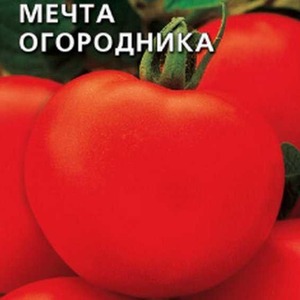
The average weight of the fruit is 160-180 g, the shape is round, the color is deep red. The taste is excellent, sweet due to the high content of sugar and lycopene. The pulp is fleshy and juicy, there are many seeds.
The photo shows the tomatoes A Gardener's Dream.
Tomato belongs to salad vegetables, so it is ideal for preparing various fresh dishes. Also, ripe vegetables are put into processing for tomato products, getting excellent juices.
Ripe tomatoes are stored for a long time and retain their presentation in long-term transportation.
How to grow seedlings
Sowing seeds for seedlings begins in mid-March. Before sowing, the seed material undergoes a special treatment to improve germination and healthy growth.
Seed preparation
The first stage in preparation is seed rejection. They are laid out on the table and carefully examined for visible damage. Then check for emptiness by immersion in saline solution for 10 minutes.
Empty seeds float to the surface... For disinfection, the seeds are placed in a weak solution of potassium permanganate for 30 minutes. After all procedures, they are thoroughly washed with running water and dried.
To improve germination, seed is germinated on wet gauze for 2 days in a dark place at a temperature of 27 ° C. As it dries, the gauze is slightly moistened with warm water. When sprouts appear, the seeds can be sown in the ground.
Capacity and soil
Sprouts are planted in a common wooden box or in separate plastic and peat cups. At the bottom of the planting containers, small drainage holes are made and treated with a dark solution of manganese. Disinfection of containers is especially important if these containers were used for last year's plantings, since disease-causing spores can remain in them.
The soil is prepared by mixing equal amounts of garden soil with turf and adding a little humus.Everything is thoroughly mixed and spilled with a hot solution of potassium permanganate. The resulting soil is laid out in planting containers, filling them in half. During the growth of seedlings, the remaining soil is added to the containers. This technique ensures that the necessary nutrients are obtained throughout the entire seedling period.
Sowing
The seeds are buried 1 cm with a distance of 2 cm from each other and sprinkled with peat on top. Slightly compacted, watered with a spray bottle with warm, settled water and cover the containers with glass or film. Until the emergence of shoots, containers are left in a bright and warm room at a temperature of 23 ° C.
Seedling care
When seedlings appear, the film is removed and the containers are placed on the windowsill, thereby providing good lighting. The duration of daylight hours is 12 hours. If additional illumination is required, fluorescent lamps are installed.
Watered as the top layer of the soil dries up using a shallow watering can with warm, settled water. It is impossible to overmoisten the soil, as the development of fungal diseases is possible. After watering, the soil is loosened, ensuring air permeability.
After the appearance of 2 true leaves, the seedlings are dived, seated in separate containers. When picking, only weak and healthy seedlings are left for further growth.
reference... The picking contributes to the enhanced build-up of the side roots.
If the seedlings are left in a common wooden box, the distance between the seedlings is increased to 15 cm.
After picking, the seedlings are fed with a full range of mineral fertilizers. Top dressing is combined with watering.
2 weeks before planting in the ground, the seedlings are hardened in the open air. Initially, the time spent on the street is 40 minutes, it is gradually increased to 11 hours. Simultaneously with daytime hardening, the night temperature is lowered to 13 ° C.
How to grow tomatoes
After 2 months, the seedlings are ready for transplantation. They are planted in a greenhouse in early May, and under film shelters 1-2 weeks later, when the soil warms up to 17 ° C.
Landing
The soil is dug up with the introduction of humus and shallow holes are made, on the bottom of which 1 tablespoon of superphosphate or wood ash is placed. The wells are filled with warm water.
Planting scheme: 40 cm - distance between seedlings, 60 cm - distance between rows. For 1 sq. m place no more than 4 plants.
After transplanting, the holes are compacted, moderately watered with warm water and leave the young bushes to get used to the new conditions.
Further care
Regular watering is established as the seedlings take root. Watered 2 times a week with settled water under the root of the plants. To keep moisture in the beds longer, they are mulched with peat or straw. After watering, the soil is loosened and weeds and roots are removed.
reference. Mulching protects against overgrowth of weeds.
The danger of weeds overgrowing is that they take a large amount of nutrients from the soil that are necessary for the development of tomatoes. In addition, pathogenic spores and pests multiply in the weed grass.
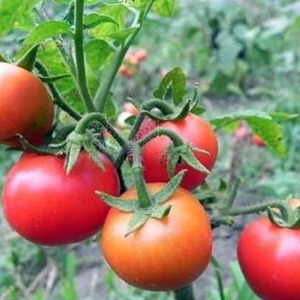 Top dressing make 3-4 times per season. They are fed with fertilizers containing phosphorus and potassium substances, alternating with organic matter.
Top dressing make 3-4 times per season. They are fed with fertilizers containing phosphorus and potassium substances, alternating with organic matter.
During flowering, fertilize with a mineral complex with a high content of phosphorus elements, and during fruiting, potash is added.
From organic matter, an infusion of mullein or bird droppings is used at a dilution of 1:15.
Features in care and possible difficulties
Despite the determinant type, plants need garter and pinching... Not only the stem is tied to vertical or horizontal supports, but also fruitful branches. When transplanting, next to each bush, wooden stakes or metal rods are installed, to which the plant is fixed.
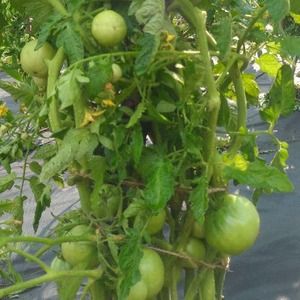 As for the horizontal support, this is the most practical fixing option. From different sides of the beds, a wire is pulled between the metal supports and the branches are fixed to the wire with soft fabric tapes. The trellis tie makes harvesting easier.
As for the horizontal support, this is the most practical fixing option. From different sides of the beds, a wire is pulled between the metal supports and the branches are fixed to the wire with soft fabric tapes. The trellis tie makes harvesting easier.
The formation of a crop is necessary for a full harvest. The plant is formed into 1 or 2 stems, removing all lateral stepsons. They go to stepchildren early in the morning, so that all the wounds can heal by evening. Places of cuts are sprinkled with ash to prevent infection.
Diseases and pests
In greenhouse conditions, the likelihood of being affected by fungal diseases increases. This is due to the fact that high temperature and humidity levels are often observed in protected structures. Although the culture has established itself as highly resistant to such infections, it is recommended to observe preventive measures without fail.
Prevention includes moderate watering, systematic loosening and mandatory daily airing. Compliance with the rules of crop rotation helps to strengthen the immunity of plants.
Before planting, the earth is spilled with a manganese solution and treated with copper sulfate, which kills fungal spores.
Of the pests for tomatoes, spider mites, aphids, a bear and slugs are dangerous. Treatment with soapy water or ammonia saves from slugs and aphids. To scare away the bear from the beds, it is enough to plant onion arrows next to the tomatoes or dig chopped cloves of garlic into the soil. Medvedka is dangerous because it moves underground and it is difficult to notice it. Therefore, experienced summer residents do not wait for the insect to damage the root system, and immediately after planting in the ground, they take the necessary measures.
As for the Colorado potato beetle, it is harvested by hand, carefully examining each seedling from all sides. With a large accumulation of pests, use the drug "Prestige".
reference... The Colorado potato beetle is capable of destroying up to 75% of all plantings.
Nuances in tomato cultivation
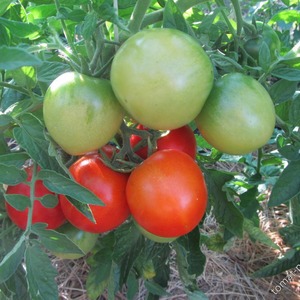 Despite the low growth of seedlings, do not thicken the plantings too much. When thickened, plants suffer from a lack of light, which leads to negative consequences. In addition, the bushes are not ventilated, which causes diseases.
Despite the low growth of seedlings, do not thicken the plantings too much. When thickened, plants suffer from a lack of light, which leads to negative consequences. In addition, the bushes are not ventilated, which causes diseases.
The lower leaves must be removed before the first fruiting branch so that they do not come into contact with wet beds. Otherwise, the leaves will rot and the plant will get sick.
When cultivating any crop in a greenhouse, it is best to use drip irrigation. This eliminates many additional difficulties, including the increased level of humidity in the beds. For drip irrigation, a regular plastic bottle without a bottom is installed with its neck down and filled with water. From it, moisture gradually enters the root system.
Harvesting and application of the crop
At the end of June, the first vegetables ripen. It is not necessary to allow tomatoes to overripe, they are removed on time, unloading the bush for subsequent ripening.
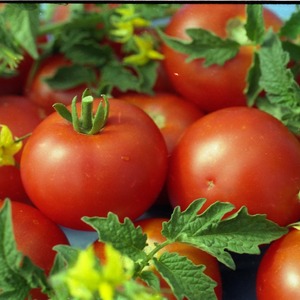 The salad variety is ideal for fresh consumption. Tomatoes make great salads, hot and vegetable dishes, fresh juices and snacks. In addition to freshly squeezed tomatoes, canned juices are made, in which vegetables perfectly retain their taste.
The salad variety is ideal for fresh consumption. Tomatoes make great salads, hot and vegetable dishes, fresh juices and snacks. In addition to freshly squeezed tomatoes, canned juices are made, in which vegetables perfectly retain their taste.
Ripe tomatoes do not lose their presentation for a long time and can withstand long transportation.
Advantages and disadvantages of the variety
Based on the reviews from the photo, we can confidently assert about the many benefits of culture:
- uncomplicated agricultural technology;
- disease resistance;
- high productivity;
- early ripening;
- low compact bushes;
- excellent fruit taste;
- marketable condition;
- long-term storage;
- long transportation.
Of the shortcomings, the obligatory garter and the formation of plants are distinguished.
Farmers reviews
By the positive feedback from those who planted the culture in their garden, one can judge its popularity. Here are some opinions:
Ksenia, Taganrog: «I dropped it off for the first time 2 years ago on the advice of a friend.She practically did not spend any effort or time on leaving. The plants are strong and powerful. I took off the first tomatoes at the end of June and immediately fell in love with their taste. Then I realized: I will not plant any large varieties. "
Margarita, Syzran: “I love this tomato for its ease of care and the unusual taste of ripe vegetables. I have been planting for more than one year and am always happy with the result. The variety does not get sick, does not require special attention - this is exactly what I need. I use the fruits not only for summer salads, but also make juices from them for the winter. "
Conclusion
The dream of every gardener has come true! In all regions, you can grow an early ripe tomato with excellent fruits. It is not only distinguished by a high rate of fruiting, but it is also immune to dangerous diseases and is so easy to care for that even a beginner in gardening will successfully master its agricultural technique. And the pronounced taste properties of ripe tomatoes are the main decoration of any dish.